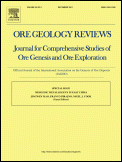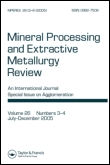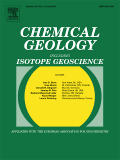
Minerals
Scope & Guideline
Connecting academia and industry through mineral knowledge.
Introduction
Aims and Scopes
- Mineral Processing and Recovery Techniques:
Research on novel methods for the extraction, processing, and recovery of minerals, including innovative flotation techniques, hydrometallurgical processes, and biotechnological approaches. - Geochemical and Mineralogical Studies:
Studies focused on the geochemistry of minerals, including their formation, alteration, and the environmental impacts of mining activities. - Petrogenesis and Tectonic Context:
Investigations into the origin and evolution of rocks, particularly granitic and volcanic formations, with implications for tectonic processes and mineralization. - Environmental and Ecological Impact Assessments:
Research addressing the ecological consequences of mining and mineral processing, including contamination assessments and sustainable practices. - Advanced Characterization Techniques:
Application of cutting-edge analytical methods, such as LA-ICP-MS, XRD, and spectroscopy, to characterize mineral properties and behaviors. - Nanotechnology and Innovative Materials:
Exploration of the use of nanoscale materials and technologies in mineral applications, including their roles in catalysis, remediation, and material science.
Trending and Emerging
- Sustainable Mining Practices:
Research increasingly emphasizes sustainable mining, including waste recycling, eco-friendly extraction methods, and the reduction of environmental impacts from mining activities. - Critical and Rare Metals:
There is a growing focus on the exploration, extraction, and recovery of critical and rare metals, driven by their importance in technology and renewable energy applications. - Machine Learning and Data Analytics in Geosciences:
The application of machine learning and advanced data analytics is on the rise, enhancing mineral exploration, resource estimation, and process optimization. - Biogeochemistry and Microbial Interactions:
Emerging studies explore the role of microorganisms in mineral processing, bioleaching, and the biogeochemical cycles of metals, highlighting innovative approaches to resource recovery. - Mineral-Based Materials for Environmental Applications:
Research on the use of minerals in environmental remediation and sustainability, including the development of new materials for water treatment and carbon capture.
Declining or Waning
- Traditional Mineralogy:
Research focused solely on classical mineralogy without integration of modern analytical techniques or interdisciplinary approaches appears to be waning. - Conventional Mining Techniques:
Studies centered on traditional mining methods are becoming less frequent as the emphasis shifts towards sustainable and environmentally friendly practices. - Single-Mineral Studies:
Research focusing exclusively on individual minerals, without context to broader geological or environmental systems, is being overshadowed by more integrative studies. - Historical Mining Practices:
There is a noticeable decline in research solely dedicated to historical mining practices, as contemporary issues and sustainable practices take precedence. - Geotechnical Engineering without Mineral Context:
Research in geotechnical engineering that does not incorporate mineralogical insights or impacts is becoming less relevant in the journal's scope.
Similar Journals

MINERALOGY AND PETROLOGY
Exploring the Depths of Earth's MaterialsMINERALOGY AND PETROLOGY, published by Springer Wien, is a premier academic journal that has been contributing to the fields of geochemistry, petrology, and geophysics since its inception in 1987. With an ISSN of 0930-0708 and an E-ISSN of 1438-1168, this journal is recognized for its rigorous peer-reviewed articles that advance the understanding of mineral and rock formation processes, their physical and chemical properties, and the implications for broader Earth sciences. Holding a respectable impact factor and categorized in the Q2 quartile for both Geochemistry and Petrology, as well as Geophysics, MINERALOGY AND PETROLOGY ranks favorably among its peers, placing it within the top 50% of scholarly publications in these fields. Researchers, professionals, and students alike will find a wealth of knowledge in its pages, as it serves as a valuable resource for those aiming to explore the complexities of Earth's materials and compositions. Although it does not offer an Open Access option, the journal assures high-quality, impactful research that is crucial for ongoing advancements in Earth sciences.

ORE GEOLOGY REVIEWS
Advancing the Frontiers of Ore GeologyORE GEOLOGY REVIEWS is a premier academic journal published by Elsevier, renowned for its influential contributions to the fields of Economic Geology, Geochemistry, and Petrology, and Geology. With its esteemed Q1 ranking across these disciplines in 2023, it occupies a leading position in shaping scholarly discussions and advancements within the geological sciences. With an impressive Scopus ranking—47th in Earth and Planetary Sciences for Geology, and among the top 40 in Geochemistry and Petrology—this journal serves as an essential resource for researchers, professionals, and students committed to advancing knowledge in ore geology. Having transitioned to an Open Access model in 2022, ORE GEOLOGY REVIEWS enhances the accessibility of high-quality research, promoting wider dissemination and engagement with cutting-edge findings from 1986 to 2024. As a valued publication addressing the intricacies of ore deposits and geochemical processes, it aims to foster interdisciplinary collaboration and innovation in the field.

BOLETIN GEOLOGICO Y MINERO
Bridging Academia and Earth Science ExpertiseBOLETIN GEOLOGICO Y MINERO is a significant academic journal published by the Instituto Geológico Minero de España, focusing on the fields of Geology and Geochemistry. Established in 1980, this journal provides a platform for researchers to disseminate vital studies and findings in the earth sciences, encompassing an array of topics from mineralogy to environmental geology. Despite its Q4 ranking in both Geochemistry and Petrology and Geology categories as of 2023, the journal serves as a resource for emerging research and innovative methodologies in these critical fields, promoting a deeper understanding of geological processes and materials. While currently operating without an open-access model, the journal is committed to advancing knowledge through rigorous peer-review standards. With its roots in Spain, the BOLETIN GEOLOGICO Y MINERO significantly contributes to the European geological research community and remains an invaluable resource for students, professionals, and researchers alike engaged in the pursuit of geological science.

Physicochemical Problems of Mineral Processing
Advancing the Frontiers of Mineral Processing KnowledgePhysicochemical Problems of Mineral Processing is a prestigious journal that serves as a vital resource in the fields of Economic Geology, Geology, Materials Chemistry, Physical and Theoretical Chemistry, and Process Chemistry and Technology. Published by OFICYNA WYDAWNICZA POLITECHNIKI WROCLAWSKIEJ in Poland, this journal has been a cornerstone of interdisciplinary research since its inception in 2008, with a commitment to advancing our understanding of mineral processing through innovative physicochemical methodologies. With a respectable Q3 category ranking across multiple disciplines and Scopus rankings that reflect its growing impact and relevance, the journal invites researchers, professionals, and students to explore cutting-edge studies, original articles, and case reports aimed at enhancing the mineral processing field. While the journal does not offer open access, it provides valuable insights and contributions to the global academic community, making it essential reading for those looking to push the boundaries of knowledge in this critical area.

Mining of Mineral Deposits
Empowering Researchers in Mineral DepositsMining of Mineral Deposits, published by the NATIONAL MINING UNIVERSITY in Ukraine, stands as a pivotal journal in the fields of engineering and earth sciences, evidenced by its commendable rankings across various categories, including a Q1 classification in Engineering (miscellaneous) and notable placements in Geochemistry and Geotechnical Engineering (Q2) for 2023. With an ISSN of 2415-3435 and E-ISSN 2415-3443, this journal provides a dedicated platform for researchers, professionals, and students alike to disseminate significant findings pertaining to mineral deposits and mining technologies. The journal has evolved over the years, bridging vital research gaps since its inception in 2016, and aims to enhance knowledge and collaboration within the mining community. Although it operates under limited access options, its rigorous peer-review process ensures that only high-quality research is published, all contributing to its respectable impact factor and visibility in the academic landscape. Located in Dnipropetrovsk, this journal not only serves as a repository of knowledge but also promotes advancements in sustainable mining practices and resource management, making it an essential resource for those engaged in mineral exploration and extraction.

Mineral Processing and Extractive Metallurgy-Transactions of the Institutions of Mining and Metallurgy
Transforming Knowledge into Mining ExcellenceMineral Processing and Extractive Metallurgy - Transactions of the Institutions of Mining and Metallurgy is a premier journal published by SAGE Publications Inc that aims to provide a dynamic platform for researchers, professionals, and students in the fields of mineral processing, extractive metallurgy, and related disciplines. With an ISSN of 2572-6641 and E-ISSN 2572-665X, this journal spans a diverse range of topics including geochemistry, geotechnical engineering, and the latest advancements in mining technologies. Currently classified in the Q3 quartile across various categories, it holds commendable rankings in Earth and Planetary Sciences and is recognized for its impactful contributions to the science of resource extraction. The journal accepts contributions from both theoretical and applied perspectives, fostering a multidisciplinary approach to mineral resource utilization. Researchers can access cutting-edge studies that break new ground in extraction techniques and processing innovations, enhancing the sustainability of mining operations. Since its inception in 2018, it has consistently attracted a global readership, making it an essential resource for those dedicated to advancing the fields of geology and metallurgy.

Boletin de Ciencias de la Tierra
Catalyzing Environmental Awareness through Scholarly WorkBoletin de Ciencias de la Tierra is a distinguished open-access journal dedicated to the field of Earth and Planetary Sciences, published by the Universidad Nacional de Colombia, Sede Medellín. Since its transition to open access in 2006, it has become an essential platform for disseminating high-quality research that addresses critical geological and environmental issues pertinent to Latin America and beyond. With an ISSN of 0120-3630 and an E-ISSN of 2357-3740, the journal aims to promote scientific dialogue and share innovative findings in various areas including geology, geochemistry, and environmental sciences. Although it currently holds a Scopus rank of #184 in the General Earth and Planetary Sciences category, indicating a percentile of only 5, Boletin de Ciencias de la Tierra is committed to fostering a rich academic discourse and enhancing the visibility of scholarly works. Situated in Medellín, Colombia, the journal serves as a vital resource for researchers, professionals, and students looking to explore advancements and participate in the global conversation on Earth sciences.

JOURNAL OF MINING SCIENCE
Elevating Standards in Geotechnical Research and DevelopmentJOURNAL OF MINING SCIENCE, published by PLEIADES PUBLISHING INC, is a leading platform for research and development in the fields of geology, geotechnical engineering, and engineering geology. With an ISSN of 1062-7391 and E-ISSN of 1573-8736, this journal has established itself as a notable contributor to the mining and earth sciences communities since its inception in 1991. The journal is indexed in prestigious databases and currently holds a Q3 ranking in both geology and geotechnical engineering categories, recognizing the impact and quality of the research it publishes. Although it does not offer open access, it provides extensive insights from cutting-edge studies that appeal to researchers, professionals, and students alike. The Journal of Mining Science aims to disseminate significant advancements in mining technology and its environmental implications, promoting sustainability and innovation within the industry. With its comprehensive scope and commitment to excellence, this journal serves as an invaluable resource for stakeholders in academia and industry striving to enhance their knowledge and practices in mining science.

Mineral Processing and Extractive Metallurgy Review
Unlocking the Potential of Mineral Resources through ResearchMineral Processing and Extractive Metallurgy Review, published by Taylor & Francis Inc, is a leading academic journal dedicated to advancing the field of mineral processing and extractive metallurgy. With a strong focus on innovative research and methodological advancements, this journal serves as a critical resource for researchers, professionals, and students alike, offering insights into the latest developments in the extraction and processing of minerals. Currently holding a prestigious Q1 ranking across multiple categories, including Chemistry (Miscellaneous), Economic Geology, and Mechanical Engineering, it demonstrates a significant impact in the scientific community, evidenced by its ranking in the 93rd percentile in Mechanical Engineering and Geotechnical Engineering. This journal is pivotal for anyone involved in the study and application of mineral resources, making it an essential read for those looking to deepen their understanding of the relationship between mineralogy and technology-driven solutions in modern engineering. In addition to its traditional subscription-based model, the journal aims to promote wider accessibility to such crucial knowledge within the industry.

CHEMICAL GEOLOGY
Illuminating Earth’s Mysteries with Cutting-Edge ResearchChemical Geology is an esteemed international journal published by Elsevier, dedicated to the rigorous exploration of geochemistry and petrology, with its foundational roots tracing back to 1966. As evidenced by its impressive Q1 ranking in both Geochemistry and Petrology as well as Geology in the 2023 category quartiles, this journal stands as a premier outlet for cutting-edge research and innovative methodologies within these vital fields. With a Scopus rank placing it in the top 10% of Earth and Planetary Sciences, Chemical Geology offers a platform for researchers, professionals, and students alike to disseminate findings that advance our understanding of geological processes and materials. Although it does not currently offer open-access options, the journal remains committed to high-quality publications that contribute significantly to the scholarly community. Located in the vibrant academic milieu of Amsterdam, Netherlands, Chemical Geology is an essential resource for those engaged in the earth sciences, aiming to bridge theoretical insights with practical applications.